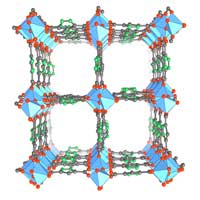 Metal-organic frameworks (MOFs) are sponge-like organic-inorganic hybrid materials and have a variety of uses due to their ultra-high porosity, or the ratio of pores or air pockets to the solid material. Through a technique called post-synthetic modification, researchers were able to enhance and modify the function of these materials for specific purposes.
Metal-organic frameworks (MOFs) are sponge-like organic-inorganic hybrid materials and have a variety of uses due to their ultra-high porosity, or the ratio of pores or air pockets to the solid material. Through a technique called post-synthetic modification, researchers were able to enhance and modify the function of these materials for specific purposes.
Tuesday, June 9, 2020
A 'hole' lot of sponge! New technique to create super-sponges is a game changer
 Metal-organic frameworks (MOFs) are sponge-like organic-inorganic hybrid materials and have a variety of uses due to their ultra-high porosity, or the ratio of pores or air pockets to the solid material. Through a technique called post-synthetic modification, researchers were able to enhance and modify the function of these materials for specific purposes.
Metal-organic frameworks (MOFs) are sponge-like organic-inorganic hybrid materials and have a variety of uses due to their ultra-high porosity, or the ratio of pores or air pockets to the solid material. Through a technique called post-synthetic modification, researchers were able to enhance and modify the function of these materials for specific purposes.
Renewable fuel from carbon dioxide with the aid of graphene and solar energy
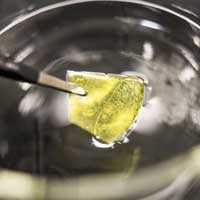 Recent research results have shown that it is possible to use a novel technique to selectively produce methane, carbon monoxide or formic acid from carbon dioxide and water.
Recent research results have shown that it is possible to use a novel technique to selectively produce methane, carbon monoxide or formic acid from carbon dioxide and water.
A metal organic framework material opens the door for deeper than ever biological imaging
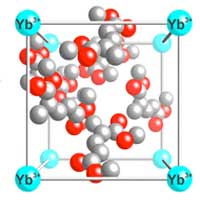 Scientists established an approach for the creation of a metal-organic framework material that provides new perspectives for the sensitization of near-infrared luminescent lanthanide ions, including unprecedented possibilities of imaging deeper in tissues for more comprehensive studies of biological systems with light.
Scientists established an approach for the creation of a metal-organic framework material that provides new perspectives for the sensitization of near-infrared luminescent lanthanide ions, including unprecedented possibilities of imaging deeper in tissues for more comprehensive studies of biological systems with light.
A new mechanism improves the efficiency of antibacterial surfaces
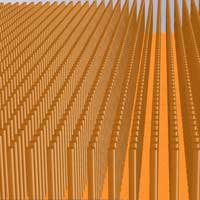 Researchers have developed a nanometric-scale theoretical model to create structures that kill bacteria by using elastic forces. The results of this study pave the way to creating new antibacterial materials.
Researchers have developed a nanometric-scale theoretical model to create structures that kill bacteria by using elastic forces. The results of this study pave the way to creating new antibacterial materials.
New nanodevice could use solar energy to produce hydrogen
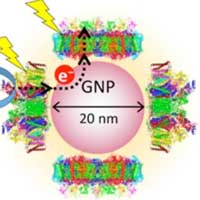 Scientists describe the design of a PSI-GNP-PSII conjugate that could be used as a platform for developing a light-driven, water-splitting nanodevice for generating hydrogen.
Scientists describe the design of a PSI-GNP-PSII conjugate that could be used as a platform for developing a light-driven, water-splitting nanodevice for generating hydrogen.
Spontaneous formation of nanoscale hollow structures could boost battery storage
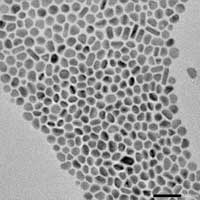 An unexpected property of nanometer-scale antimony crystals - the spontaneous formation of hollow structures - could help give the next generation of lithium ion batteries higher energy density without reducing battery lifetime. The reversibly hollowing structures could allow lithium ion batteries to hold more energy and therefore provide more power between charges.
An unexpected property of nanometer-scale antimony crystals - the spontaneous formation of hollow structures - could help give the next generation of lithium ion batteries higher energy density without reducing battery lifetime. The reversibly hollowing structures could allow lithium ion batteries to hold more energy and therefore provide more power between charges.
Building better bridges for moving energy
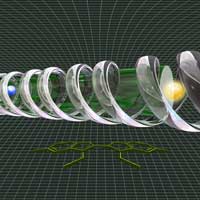 Scientists have developed a new type of nanostructure that mimics certain natural light-harvesting systems. The nanostructure is an assembly of molecules that organize using instructions in the form of DNA templates to produce a structure that measures in nanometers.
Scientists have developed a new type of nanostructure that mimics certain natural light-harvesting systems. The nanostructure is an assembly of molecules that organize using instructions in the form of DNA templates to produce a structure that measures in nanometers.
LEGO construction of nanoparticle assemblies
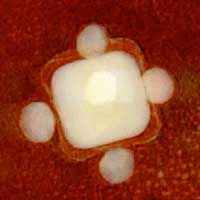 Scientists developed a new method of selectively attaching DNA strands to specific regions of nanoparticles. The DNA strands then dictate how the nanoparticles assemble into more complex architectures.
Scientists developed a new method of selectively attaching DNA strands to specific regions of nanoparticles. The DNA strands then dictate how the nanoparticles assemble into more complex architectures.
Nanodiamonds slip n' slide
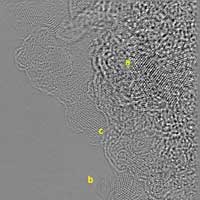 A novel dry solid lubricant includes diamond nanoparticles. It creates a surface coating that reduces friction 20-fold compared to oil-based lubricants.
A novel dry solid lubricant includes diamond nanoparticles. It creates a surface coating that reduces friction 20-fold compared to oil-based lubricants.
Harnessing light for nanotechnologies
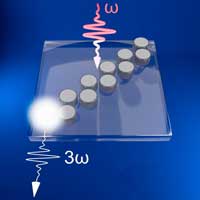 Scientists found a new way to build silicon nanodisks - extremely tiny, flat, round objects. With this new technology, scientists can guide light along the outside of these tiny structures in a way they have never been able to before.
Scientists found a new way to build silicon nanodisks - extremely tiny, flat, round objects. With this new technology, scientists can guide light along the outside of these tiny structures in a way they have never been able to before.
Snapshot of exploding oxygen
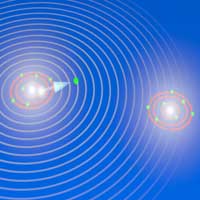 Physicists used a new experimental technique to 'X-ray' molecules such as oxygen and view their motion in the microcosm for the first time.
Physicists used a new experimental technique to 'X-ray' molecules such as oxygen and view their motion in the microcosm for the first time.
Experiment shows for the first time in detail how electrolytes become metallic
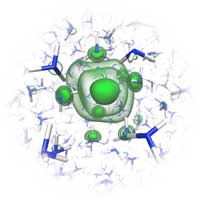 An international team has developed a sophisticated experimental technique to observe the formation of a metallic conduction band in electrolytes.
An international team has developed a sophisticated experimental technique to observe the formation of a metallic conduction band in electrolytes.
A promising cobalt compound for ultra-thin layers
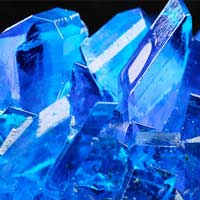 Researchers have manufactured a novel, highly versatile cobalt compound. The molecules of the compound are stable, extremely compact and have a low molecular weight so that they can be evaporated for the production of thin films.
Researchers have manufactured a novel, highly versatile cobalt compound. The molecules of the compound are stable, extremely compact and have a low molecular weight so that they can be evaporated for the production of thin films.
With a twist, researchers make a device breakthrough
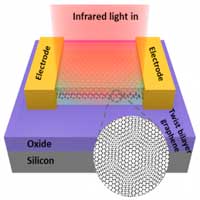 Putting their own spin on the field of 'twistronics', a team of researchers has found that similar methods can elicit properties that could lead to new optoelectronic devices.
Putting their own spin on the field of 'twistronics', a team of researchers has found that similar methods can elicit properties that could lead to new optoelectronic devices.
Armor on butterfly wings protects against heavy rain
 The research showed how microscale bumps, combined with a nanoscale layer of wax, shatter and spread these drops to protect fragile surfaces from physical damage and hypothermia risk.
The research showed how microscale bumps, combined with a nanoscale layer of wax, shatter and spread these drops to protect fragile surfaces from physical damage and hypothermia risk.
Liquid metals break down organic fuels into ultra-thin graphitic sheets
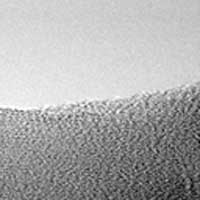 For the first time, researchers show the synthesis of ultra-thin graphitic materials at room temperature using organic fuels. These fuels can be as simple as basic alcohols such as ethanol.
For the first time, researchers show the synthesis of ultra-thin graphitic materials at room temperature using organic fuels. These fuels can be as simple as basic alcohols such as ethanol.
For the first time, researchers focus plasmons into nanojet
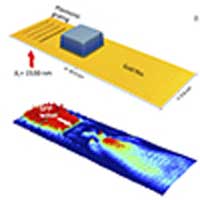 Researchers have been able to experimentally confirm a plasmonic nanojet effect previously forecast in practice. In the future, the effect of plasmon compression can make optical electronics competitive and boost the creation of an optical computer.
Researchers have been able to experimentally confirm a plasmonic nanojet effect previously forecast in practice. In the future, the effect of plasmon compression can make optical electronics competitive and boost the creation of an optical computer.
Machine learning predicts nanoparticles' structure and dynamics
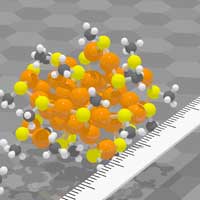 Researchers have demonstrated that new distance-based machine learning methods are capable of predicting structures and atomic dynamics of nanoparticles reliably. The new methods are significantly faster than traditional simulation methods used for nanoparticle research.
Researchers have demonstrated that new distance-based machine learning methods are capable of predicting structures and atomic dynamics of nanoparticles reliably. The new methods are significantly faster than traditional simulation methods used for nanoparticle research.
Subscribe to:
Comments (Atom)
